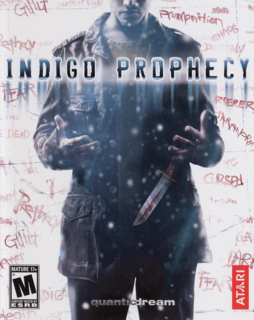Quantic Dream's adventure game helps re innovate the genre in many ways.
This game is a joy to play. Reactions, imagination, creativity and puzzle solving are on display here, and it's a fine exhibition. The controls are simple....90% of the primary actions are performed with the right analog stick, while movement and standard features are performed with the regular buttons.
You control 3 main characters, which you'll sometimes have the opportunity to switch from as the story advances, and other times when you can do it as often as you like (Tyler and Carla, the two police officers, get this in bucketloads) One persons actions can effect the other, although they tend not to be too drastic. What someone does in one timeframe, however, can effect others. Mopping up a bloodstain will mean the police might not notice the stain on the floor, but may well notice it on the mop, for example.
There are a few categories that the game presents that all require discussing. There are action sequences, where you get two 4-direction colored segments appear on the screen, you'll get a prompt, and they'll begin to glow, you press the direction they're in, and if you're successful, you're treated to your controlled character doing well in the background. Only problem is, some of the more crazy, fast parts will leave you concentrating on the display rather than the actions in the background, which is a shame.
There are exertion bits, where your character is doing usually routine actions or forcing something, which involves back-and-forth use of the L and R buttons in rapid succession, and you must fill the meter into the last three segments of the meter, where you'll be awarded with it glowing, and your character usually succeeding. Sometimes you have to just get it there, sometimes you just have to make it go up as quickly as possible, and sometimes you have to maintain the pace for a long duration; whichever challenge comes up, be sure your forearms will ache at times.
There are manual actions which involve movements with the right stick. Things like climbing fences (moving the stick left to up for the left arm, then right to up with the other, then at the top moving it up and around to the left to represent climbing over, for example). This is almost always easy, and just requires semi-accurate motions with the stick.
Conversations are interesting, as you have a limited time to use the right stick to push a direction associated with a category. You must try to keep the conversation going by not angering the other person by asking the wrong question, which could result in a mood penalty or a mood bonus. You'll sometimes have to choose your responses wisely, like if you're being interrogated, you can often choose to joke, lie, tell the truth, or dodge the question, with some options being there and some others not, and the wrong category can lead to you rousing suspicion.
Due to the dark nature of the story, your characters will have a mood meter. It ranges from neutral (at the top) to wrecked (right near the bottom, which I never got lower, but believe it.....pixel-lines on the meter were left) which represents your characters state of mind on the matters at hand. Relaxing, having a bite to eat, listening to their favorite tune, etc., will increase your mood by a varying degree, where as begging chewed out by someone, headaches, bad memories and screwing up a past-time can make you become gradually more depressed. Apparently, if your meter runs out, you commit suicide, but thankfully there are parts on each main characters story where you can greatly increase their mood before taking part in a critical part of the story that will almost certainly drain their mood.
Combine all this and you have a great game. Due to it's story and paths in it, you'll always wonder what would happen next. You'll want to take actions that will give you a sense of accomplishment as you go on. The even pacing for the most part will keep you intact and busy. Add the amazing atmosphere that sets the mood and it works.
Yet, it has it's flaws. Near the end of the game gets nonsensical and had a bit of a rushed feeling. The story isn't perfect and needs explanation on a few things because of it. The camera could use some work in certain areas. The graphics aren't very pleasing to the eyes due to some not that great looking models but it does get the job done well with a solid art direction. The voice acting is fantastic and keeps the characters alive, while it combines licensed music with an original score in ways that make perfect sense. The licensed music ranges from decent alternative rock to even-more-decent down-tempo grooves, and the score, created by Lost Highway and Mulholland Drive composer Angelo Badalamenti, presents brilliantly melancholy tones from a minimalist string set.
All this adds up to being such an amazing game. It's highly replayble with multiple endings depending on your actions and different events would occur as well. Quantic Dream simply wanted it to feel like a interactive film and did well with it. Taking a genre like this and reinventing it in a good way. Even it's flaws can't stop it from being well done.
Final score 9.0/10

